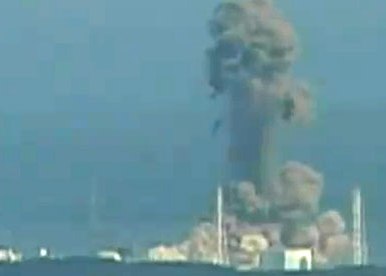 Japan’s nuclear safety agency is maintaining its level four rating of the accident at the country’s Fukushima nuclear plant, despite France’s watchdog upgrading the situation to a level six – placing it second to Chernobyl as the world’s worst nuclear disaster.
Japan’s nuclear safety agency is maintaining its level four rating of the accident at the country’s Fukushima nuclear plant, despite France’s watchdog upgrading the situation to a level six – placing it second to Chernobyl as the world’s worst nuclear disaster.
Two more reactors at the troubled nuclear power plant appear to have lost cooling functions as the plant’s operators struggle to contain what threatens to become a meltdown.
Explosions at the four other reactors at the plant followed the losses of their cooling systems after Friday’s massive earthquake and tsunami.
Radiation levels rose to harmful levels at the facility earlier today, 250 kilometres north-east of Tokyo, where nearby residents were urged to stay indoors or evacuate.
“There is no discussion here about upgrading the international nuclear accident rating for the Fukushima plant,” an official at Japan’s Nuclear and Industrial Safety Agency said.
But Andre-Claude Lacoste of France’s Nuclear Safety Authority said: “The order of gravity has changed.”
“The incident has taken on a completely different dimension compared to yesterday. It is clear that we are at level six.”
The 1979 accident at Three Mile Island in Pennsylvania rates five on an international scale of zero to seven, while Chernobyl is put at seven, the highest.
Level 3 indicates a “serious incident” according to the International Atomic Energy Agency (IAEA) scale, while level four means there has been an “accident with local consequences”. Level 6 is a “serious accident”.
The 1986 explosion at the Soviet nuclear power plant in Chernobyl – rated a maximum 7 – was the world’s worst nuclear disaster, with death toll estimates ranging from 4,000 to tens or even hundreds of thousands.
Mr Lacoste also said the concrete vessel around reactor No.2 at the plant, designed to contain radioactive debris, was “no longer sealed”.
The confinement vessel, made out of reinforced concrete, surrounds the steel vessel that houses the nuclear reactor. It is designed to contain radioactive gas or dust, preventing them from being expelled into the air.
The agency said two “successive explosions, at 6:10am and 10:00am local time probably caused damage to the confinement vessel which is the source of the significant increase in detected radioactive releases”.
The French watchdog said it was being briefed by Japanese authorities and by a specialist from France’s Institute for Radiological Protection and Nuclear Safety (IRSN).
Japan officials has already reported apparent damage to part of the No.2 container.
Signs of trouble
Earlier, government spokesman Yukio Edano said cooling of the No.5 and No.6 reactors also appear not to be working properly, with slight rises in temperature recorded.
A official from the plant operator, TEPCO, said water in the pool storing spent nuclear fuel rods at the No.4 reactor that caught fire yesterday morning may be boiling, causing the water level to drop.
TEPCO said it may pour water to cool the spent nuclear fuel pool within two or three days
Mr Edano says the explosion at the No. 4 reactor was caused by a build-up of hydrogen.
“Spent nuclear fuel in the reactor heated up, creating hydrogen and triggered a hydrogen explosion,” he said.
The IAEA says the fire at the reactor’s spent-fuel pond has been extinguished.
The director of Japan’s nuclear and industrial safety agency, Toshiro Bannai, warns reactors No.5 and No.6 are at risk of the same problems with their spent-fuel pools.
He says the temperature in the No.4 pool more than doubled from its regular temperature of about 40 degrees Celsius.
“The alloy of the spent fuel, made from zirconium alloy, these metals react with water when its temperature rises up to [about] 100 degrees [Celsius] to produce hydrogen,” he said.
“The pools temperature is maybe 30-40 degrees [normally], it’s not a high temperature … but we need some cooling systems because spent fuel has a power of heat.”
Radiation levels
Radiation levels reached as high as 400 milisieverts an hour at the plant yesterday, thousands of times higher than readings taken before the latest blasts, but Mr Edano says radiation levels have since fallen.
The radiation level in the capital, Tokyo, was recorded at 10 times normal on Tuesday evening, but the city government said there was no threat to human health.
The levels of radiation detected in Tokyo, and neighbouring Chiba, are also said to be falling.
“It is returning closer to the normal level. But we need to keep a close watch on it,” city health and welfare official Keiichi Nakaya said.
Winds are now dispersing the radioactive material over the Pacific Ocean, away from Japan and other Asian countries, the World Meteorological Organisation (WMO) has said.
But the United Nations agency warned that although effects have been offshore so far, weather conditions could change and it was closely monitoring satellite and other data.
Trouble at the nuclear plant has sparked a rout on the stock market and panic buying in supermarkets.
Japan is struggling to cope with the enormity of the damage from Friday’s record quake and the tsunami that raced across vast tracts of its north-east, destroying all before it.
The official toll of the dead and missing has topped 10,000, with 3,373 confirmed dead.
The total number of people unaccounted for stood at 6,746, the national police agency said in its latest update – more than double the estimate it offered earlier in the day.
The number of injured stood at 1,897.
On Sunday, the police chief of Miyagi, one of the hardest-hit prefectures, said the number of deaths was expected to exceed 10,000 in his region alone.


